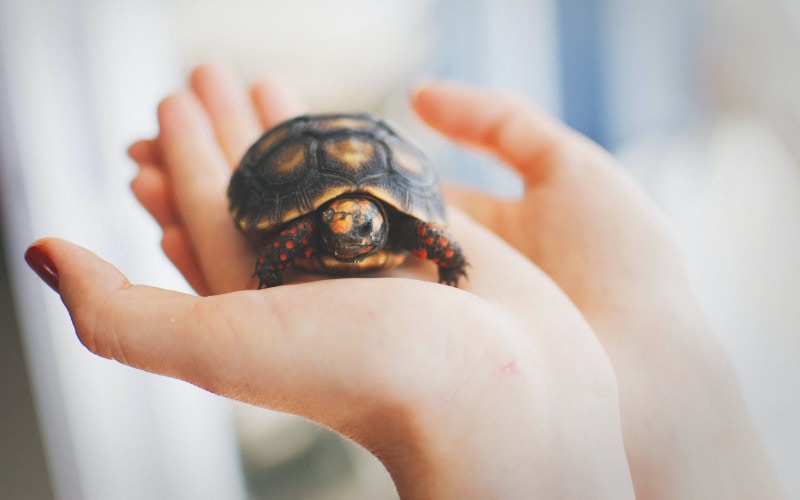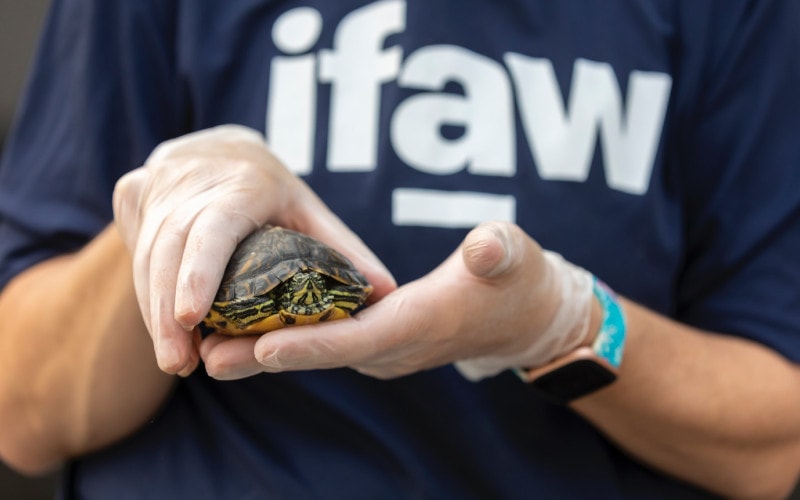
Pet ownership comes with risks and any pet has the potential to spread a zoonotic disease to their owners. These diseases can be spread in a variety of ways and it’s up to pet owners to take necessary precautions to reduce the risk of disease within the home.
It’s important to be aware of what kind of diseases your pet could transmit to you and your family. Pet reptiles are capable of spreading a few zoonotic diseases, some much more common than others. Keep reading to learn more about these diseases and what you can do to keep yourself and your family safe.
The 5 Common Diseases Pet Reptiles Can Give You
1. Salmonella

| Other Names: | Salmonellosis |
| How It Spreads: | Infection with salmonella bacteria |
| Common Symptoms: | Diarrhea, fever, chills, and abdominal pain |
Salmonella is a disease of the intestinal tract and the most common disease spread to humans from their pet reptiles. Salmonella bacteria typically live in both animal and human intestines and are shed through feces.
This bacterial disease is quite common, and humans are most often infected through contaminated water or food. Salmonella is found in all different types of reptiles and can easily spread from the reptiles to their handlers when something has been contaminated with their feces and makes its way into the mouth.
Some people who become infected with salmonella1 may have no signs or symptoms. Most will develop diarrhea, fever, and abdominal cramping sometime within 8 to 72 hours after exposure. Healthy individuals typically recover within a few days to a week without any treatment.
Those with weakened immune systems could be at risk of more severe symptoms such as dehydration, bloody stools, and a high fever. If symptoms of salmonella were to persist for longer than a few days, a medical doctor should be consulted.
Do Snakes Carry Salmonella?
Yes, just like other reptiles, most snakes carry salmonella in their digestive tract. It doesn’t harm them but can harm humans if we come into contact with it. Make sure to follow precautions when handling your snake and cleaning its enclosure.
2. Mycobacterium marinum
| Other Names: | N/A |
| How It Spreads: | Contaminated water through open cuts or wounds |
| Common Symptoms: | Single or multiple localized skin lesions at the site where bacteria entered the body |
Mycobacterium marinum is a type of bacteria that is commonly found in ponds and also in freshwater and saltwater aquariums. It most often affects fish but can also affect reptiles, amphibians, and humans.
This type of bacteria cannot be transmitted from person to person but is spread through contaminated aquarium water. Humans can become infected through open cuts or wounds when coming in contact with the aquariums their pets are kept in.
Signs a reptile has been infected with mycobacterium marinum2 are lumps, sores, or changes in skin color. If a human becomes infected, the most common sign is a raised bump or sore where the bacteria entered the body, which is typically the hands or arms. It can be either a single sore or multiple sores in a line.
Those with weakened immune systems are at higher risk of getting seriously ill, as the bacteria can potentially spread throughout the body. Some infections may improve on their own, but antibiotics are typically prescribed.
3. Leptospirosis

| Other Names: | Weil’s Disease |
| How It Spreads: | Through urine of infected animals |
| Common Symptoms: | High fever, headache, bleeding, muscle pain, chills, red eyes, jaundice, and vomiting |
Leptospirosis is a disease caused by infection with the Leptospira bacteria. These bacteria are found worldwide in soil and water and consist of many strains. Both wild and domesticated animals can carry leptospirosis and it can easily be transmitted through contact with the urine of the infected individual.
Transmission can occur through direct contact with open wounds like cuts or scratches or even via the mouth or eyes. This bacteria can also get into water or soil and survive for several weeks up to a few months.
Leptospirosis3 most commonly affects dogs but can also affect other pets like cats and reptiles. Symptoms will typically appear within 2 weeks of infection and result in a flu-like illness with a fever and persistent headache among other symptoms.
Treatment consists of antibiotics like penicillin and doxycycline. Nonsteroidal anti-inflammatories may also be recommended to help ease fever and relieve the associated muscle pain. The disease will typically resolve within a week.
4. Campylobacteriosis

| Other Names: | Campylobacter infection |
| How It Spreads: | Direct or indirect contact with Campylobacter bacteria |
| Common Symptoms: | High fever, headache, muscle pain, chills, bloating, diarrhea, bloody stools |
Campylobacteriosis is a common bacterial infection seen in humans. It results from the infection of a bacteria called Campylobacter and is typically transmitted through food or contaminated water.
Scaled reptiles have been identified as potential hosts and have resulted in the transmission of the bacteria to human handlers. According to studies, the most common hosts include bearded dragons, green iguanas, western beaked geckos, and blotched blue-tongued skinks. Snakes and other types of lizards can also transmit the infection.
Campylobacteriosis symptoms include diarrhea, abdominal pain, headache, and gastrointestinal symptoms like bloating, diarrhea, and nausea. A high fever typically hits within 2 to 5 days after infection.
Healthy individuals may have no symptoms at all and most often this infection will go away on its own with plenty of fluids and no other treatment. Antibiotics may be prescribed if a doctor’s visit is necessary.
Those with weakened immune systems like the elderly and young children and people with underlying chronic illnesses have been identified as the most vulnerable population.
5. Botulism

| Other Names: | N/A |
| How It Spreads: | Ingestion or inhalation of toxins produced by Clostridium botulinum bacteria |
| Common Symptoms: | Difficulty swallowing or speaking, facial weakness, and paralysis |
Botulism is a very rare but very serious and life-threatening condition caused by a toxin released by the Clostridium bacterium. There are three common forms of botulism including foodborne botulism, wound botulism, and infant botulism. All forms are fatal and considered medical emergencies.
Clostridium is commonly found in the soil and within mud. Animals that live close to the ground are often contaminated with this bacterium. Aquatic reptiles like turtles are the most commonly affected but Clostridium commonly contaminates many reptiles.
Older children and adults have a natural defense against this bacteria, but infants under one year of age have not yet developed this type of protection and are at serious risk. It is important to keep infants and young children away from pet reptiles for this reason.
Do Snakes Carry Diseases?
Snakes can carry any disease that other reptiles can carry, including those that are listed above which can be transmitted to humans. They may also transmit various parasites to humans. Snakes are also susceptible to a variety of diseases, but most of them won’t affect humans.
While most are preventable with proper care, some of these diseases can be deadly if not treated. If you suspect your snake is sick, it’s best to take it to a veterinarian that handles reptiles and other exotic pets.
Reducing the Risk of Disease
Wash Your Hands
Always wash your hands thoroughly with soap and warm water immediately after touching your pet reptile or any objects or substrate within their habitat. If you don’t have soap or water available, keep hand sanitizer nearby. Always supervise children when they are washing their hands after handling pet reptiles.

Wash Your Clothes
After you have finished handling your reptiles, wash your clothing and change into something clean to kill any bacteria that could have gotten onto the fabrics.
Do Not Let Those with Weakened Immune System Handle Reptiles
It is highly recommended that children younger than 5 years of age, the elderly, or anyone with a weakened immune system refrain from handling or touching any pet reptiles or amphibians. This also applies to anything in or around their habitat.
You should also never allow your pet reptiles to bathe or soak in a kiddie pool that is used by young children.
Prevent Ingestion of Harmful Bacteria

Never touch your mouth after handling any reptiles or amphibians. You should also never eat or drink around these animals to keep your risk of disease transmission low.
Keep Your Animals Secure
Always keep your pets in a secure enclosure and never allow them to free roam around the house. It is especially important that you keep them away from areas where you prepare, serve, or store food or drinks.
Clean Habitats and Contents Outside
Your reptile’s habitat and any contents like hides, water bowls, basking areas and more should be cleaned thoroughly outside of the home. For added safety, wear disposable gloves when cleaning these items, and never dispose of any water in sinks that you use for drinking water or preparing food.
Be Careful Where You Bathe the Animals

Never bathe your reptiles in the sink. It is recommended to have a designated storage tote available for reptile baths or soaks. If you must use your bathtub, make sure that you clean it thoroughly with soap and water after the fact. You should also clean all surfaces the reptile has come into contact with.
Think Before Choosing a Pet
Before you make a final decision on bringing any pet into the home, there are many things that you should take into consideration. When you are talking about reptiles, there are certain things to keep in mind before committing:
Certain Reptiles Live a Long Time
Pets are a lifelong commitment, and many reptile species have incredibly long lifespans when compared to your typical dog or cat. For example, most snakes can live up to 20 or 30 years in captivity and certain species of tortoise can live human lifespans of 70 years of age or longer.
Your Household May Not Be Ideal
You should consider your household, too. You may have people in the home who are at a higher risk of contracting an illness because of weakened immunity. This includes children under the age of 5, adults 65 years of age or older, and anyone with a compromised immune system.
Are You Ready to Care for an Exotic Pet?

Research and learn how to properly care for reptiles and amphibians before buying or adopting. Ask a veterinarian about the proper food, care, environment, and other needs of the specific pet you are interested in adopting.
You Need to Find an Appropriate Veterinarian
Locate an exotic veterinarian in your area. Reptiles and amphibians require specialized care. Most veterinarians do not treat reptiles or amphibians.
Make Sure It’s Legal
Before you bring home a reptile, make sure that you check state and local laws to make sure you can legally own that specific species in your area. You may also need to consider contacting your landlord if you are renting your home, as these kinds of pets may be prohibited.
Reptiles are often considered exotic pets and will have regulations placed on them in certain areas. It may be completely legal to own your reptile, but you could also run into the need for a permit or even laws in place against owning your animal entirely.
Conclusion
There are a few zoonotic diseases that pet reptiles can potentially spread to their owners. Young children, the elderly, and those with weakened immunity are at greater risk of serious illnesses if infected by these bacteria or diseases. If you own reptiles, make sure to take the proper safety precautions to reduce the risk of disease transmission and do what you can to keep your reptiles, yourself, and your family safe.
Featured Image Credit: Imageman, Shutterstock









